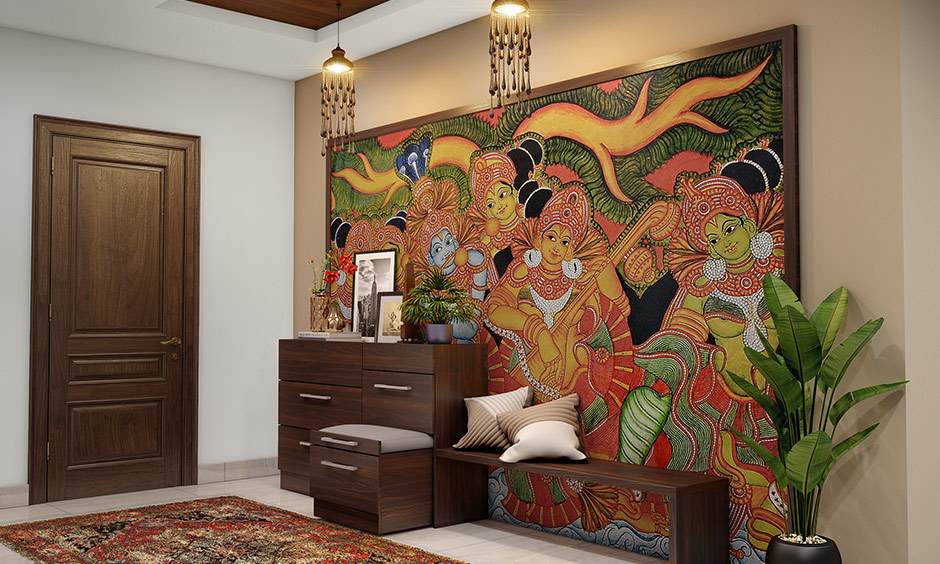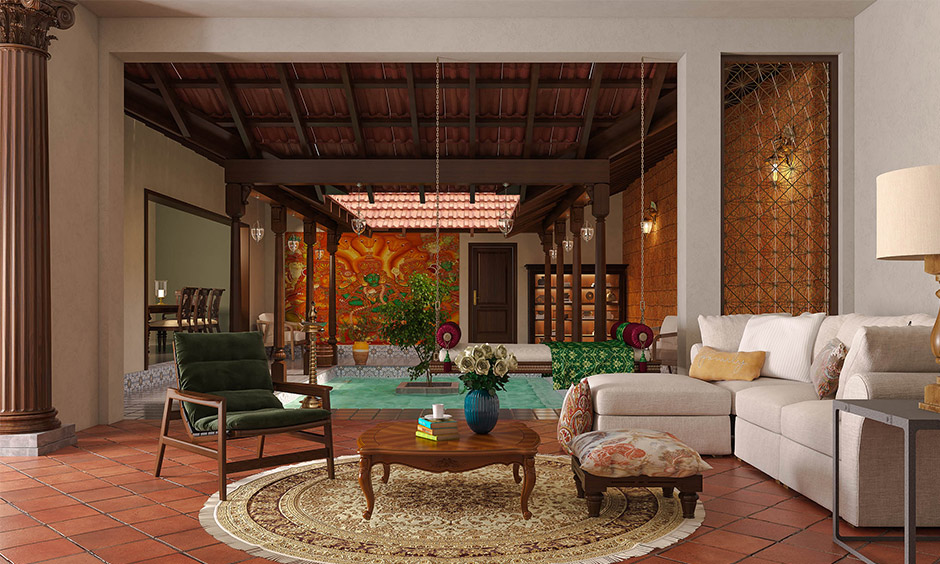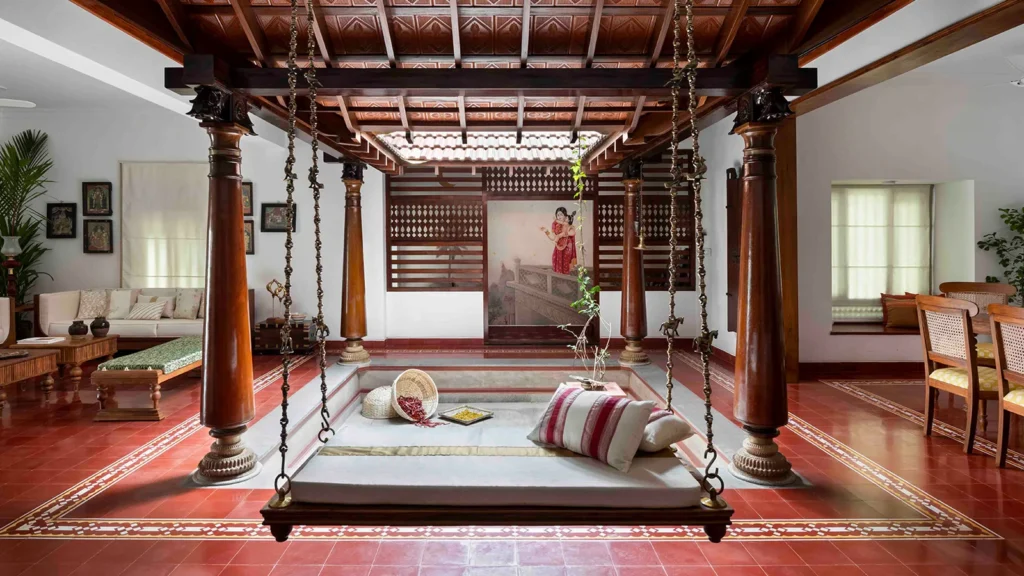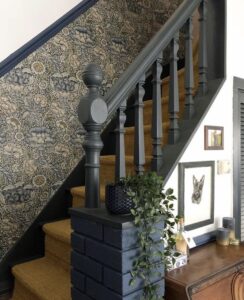Heritage Hues, Timeless Views.
India is a land of rich cultural heritage and diversity, reflected prominently in its traditional interior design. The essence of traditional Indian homes lies in their warmth, vibrant colours, intricate patterns, and a deep-rooted connection to heritage. Infusing these elements into your home can create a space that not only exudes charm but also encapsulates centuries-old traditions.

Infusing these timeless elements into your home allows for the creation of a sanctuary that not only exudes charm but also becomes a living embodiment of India’s cultural heritage. From the vibrant hues to the detailed craftsmanship, each facet contributes to crafting a space that tells stories of the past while embracing the present.
What We'll Cover
ToggleExploring Traditional Interior Design: Ideas and Tips for Cultivating Cultural Beauty

Warm Colour Palettes:
Traditional Indian homes often draw inspiration from nature, embracing warm and earthy colour schemes. These hues—such as terracotta, deep reds, ochre, and mustard yellows—infuse spaces with a cozy and inviting ambiance. Consider using these colours for walls, upholstery, or even in intricate patterns on textiles and rugs. Layering different tones can create depth and visual interest, while vibrant accents can enliven the overall atmosphere.
Decor Tip:
Experiment with colour blocking techniques by combining contrasting shades to add a contemporary twist to traditional colour palettes.
Handcrafted Furniture:
The charm of traditional Indian design lies in handcrafted furniture pieces that reflect exquisite craftsmanship. Opt for pieces crafted from natural materials like wood, bamboo, or cane. Detailed carvings on wooden sofas, ornate coffee tables, or hand-painted cabinets not only add a touch of authenticity but also serve as focal points in a room, radiating timeless elegance.
Decor Tip:
Mix and match furniture styles from different regions of India to create an eclectic yet harmonious look.
Textiles and Fabrics:
Indian textiles boast a rich legacy, showcasing diverse patterns, and textures. Introduce embroidered cushions, silk drapes, or dhurrie rugs to add texture and vibrant patterns to your space. Experiment with traditional Indian prints like paisleys, block prints, or ikat designs for a timeless appeal. These textiles not only add visual interest but also reflect India’s cultural diversity.
Decor Tip:
Use fabrics with metallic threadwork or zari (golden/silver thread) to add a touch of opulence to your space.
Statement Décor Pieces:
Adorning your home with traditional Indian art pieces adds character and tells stories of India’s cultural heritage. Brass statues, intricately designed lamps, antique pottery, or vintage wall hangings serve as beautiful décor pieces that lend a sense of history and artistry to your interiors. Each piece can be a conversation starter, showcasing the country’s rich artistic traditions.
Decor Tip:
Create curated vignettes by grouping together a mix of decorative pieces with varied heights, textures, and colours.
Fusion of Modern and Traditional:
Achieving a harmonious blend between traditional and modern elements is key to creating a captivating space. Mix traditional furniture with modern lighting fixtures or infuse contemporary artwork with traditional motifs. This fusion not only adds depth to the design but also showcases the adaptability of Indian aesthetics in a modern context.
Decor Tip:
Incorporate traditional architectural elements like wooden jharokhas or jaali screens into modern spaces for a unique fusion.
Courtyard or Veranda:
If space permits, creating a small courtyard or veranda reminiscent of traditional Indian homes can be a delightful addition. Adorn it with potted plants, a swing (jhula), or comfortable seating to evoke a sense of tranquility and serenity. These spaces often act as extensions of the home, offering a peaceful retreat for relaxation or social gatherings.
Decor Tip:
Install a water feature like a small fountain or a cascading water wall to bring soothing sounds of nature into the space.
Statement Ceilings and Architectural Details:
Exploring traditional Indian architectural elements can elevate the visual appeal of your interiors. Ornate ceilings, arches, or jaali work (intricate lattice patterns) add a sense of grandeur and uniqueness to spaces. These details create focal points and contribute to the overall charm of a room.
Decor Tip:
Use lighting strategically to highlight architectural details, casting intriguing shadows that accentuate the intricate designs.
Sacred Spaces:
Designating a sacred corner or a pooja room within your home is a way to pay homage to tradition and spirituality. Adorn it with traditional idols, incense holders, and rangoli patterns to create a serene atmosphere. These spaces serve as sanctuaries for reflection, prayer, and meditation.
Decor Tip:
Incorporate aromatic elements like sandalwood or jasmine-scented candles to enhance the ambiance of the sacred space.
That’s a Wrap
Traditional interior design serves as a gateway to the past, a vessel that carries within it the essence of cultural heritage, artistic richness, and a timeless aesthetic. The journey through traditional Indian design isn’t merely about ornamentation or aesthetics; it’s a narrative that weaves together the threads of history, customs, and craftsmanship into the very fabric of your home.
As we explored the warmth of earthy tones, the intricacies of handcrafted furniture, and the captivating allure of vibrant textiles, it becomes evident that traditional interior design isn’t just about decorating spaces—it’s about creating living narratives. These designs encapsulate stories of generations, celebrating the artistry of skilled artisans and honoring the legacy of our ancestors.
By embracing traditional design elements—whether through the vibrant hues adorning the walls, the craftsmanship reflected in every piece of furniture, or the spiritual sanctity of sacred spaces—we not only create aesthetically pleasing homes but also pay homage to the cultural depth and diversity that India embodies.

The beauty of traditional interior design lies not only in its visual appeal but also in its ability to evoke emotions, memories, and a sense of belonging. It’s an invitation to inhabit spaces that resonate with history, culture, and authenticity—a testament to the enduring charm that transcends trends and stands the test of time.
As you embark on your journey to infuse traditional elements into your home, remember that each piece, each color, and every intricate detail carries a story waiting to be told. Let your home become a canvas that showcases the rich tapestry of India’s cultural heritage, where tradition and modernity harmoniously coexist, creating spaces that are as unique as they are timeless.
May your home be a testament to the beauty of tradition and a reflection of your reverence for the timeless allure of Indian design.
Namaste!
FAQs
Traditional Indian interior design embodies warmth, vibrant colors, intricate patterns, and a deep connection to heritage. It often includes rich color palettes, handcrafted furniture, and decorative elements reflecting cultural diversity.
To blend traditional Indian design into a modern space, consider using elements like vibrant textiles, statement pieces like carved wooden furniture, brass or copper decor, and integrating them with contemporary furniture and minimalist decor.
Traditional Indian color palettes often feature earthy tones such as terracotta, deep reds, ochre, mustard yellows, and vibrant hues like saffron and turquoise, creating a warm and inviting ambiance.
Natural materials like wood, bamboo, cane, and brass are commonly used in traditional Indian furniture. Fabrics like silk, cotton, and wool with intricate embroidery or handwoven patterns are prevalent in textiles.
Designate a quiet corner or room, preferably facing east, and decorate it with idols, incense holders, rangoli patterns, and soft lighting. Use auspicious colors and incorporate traditional symbols for a serene atmosphere.
To add authenticity, opt for handcrafted furniture with intricate carvings, display traditional art pieces like brass statues or antique pottery, use richly patterned textiles, and incorporate traditional motifs in the decor.
Achieve balance by integrating modern amenities discreetly, such as using contemporary lighting fixtures with traditional furniture or incorporating smart storage solutions into antique pieces without compromising their aesthetics.





